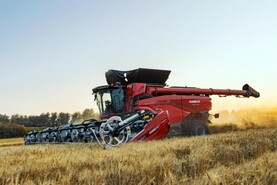About 24% of land is farmed organically in Austria and we make up part of that number, which is the highest in the EU. Right now, we’re definitely fitting the mould of what everyone thinks organic farmers do – weed control.
I moved to Austria from Scotland in 2014 and farm 56ha of arable land with my husband. We also have space for 120 fattener pigs.
With crops already in the ground, our waking hours (and many of those dreaming) are spent wondering when we should inter-row-harrow the maize and if there’s time to comb-harrow the field beans before it rains.
We gave the maize a shot this week only to find after calibrating the Einböck that the guy who sowed the crop made a slight miscalculation in one of the rows.
They need to be 60cm apart: we have one that’s 65cm. So we have to wait a few more days and will need to set the machine up again.
The maize field is also checked multiple times daily for birds. Last year, we were forced to re-sow a third of the field because of bird damage and we’re ready to try everything we can to stop it happening this year.
We’ve set up some old-fashioned scarecrows to chase them away but they just seem to be scaring our dog.
We’re still converting to organic, so this is all new to us, but we’ve learned a lot even from last year when the weeds consumed our soya and our yield was disappointingly low.
This year we got maize and soya planted a whole month earlier due to the wonderful sunny and dry weather we’ve had. So we’re hoping this helps us when it comes to harvest time. A lot of farmers here are definitely feeling the joy of spring right now.
Pigs
Roughly half of what we grow goes to feed the pigs – that’s maize, soya, field beans, triticale and a pea/triticale combi crop.
It’s quite protein-heavy but that’s what the pigs need. We sell the excess to other organic farmers in the region.
This week we’ll sell most of our fatteners to an organic processor. The stable we built last year is looking a little bare for the first time.
There’s a real shortage of organic piglets in Austria. With it being easy to convert old stables into organic ones – which need a large indoor sleeping area and a large outside run – there are a lot of fattener farmers cropping up, meaning piglets are harder to come by.
We’re patiently waiting on another delivery coming at the end of May so we’re full again. Then we’ll be moving forward with our plan to keep sows of our own so we don’t need to rely on sourcing piglets.
Part-time
It’s a frustrating process but one that’s not so critical for us because we both have other jobs. This is common in Austria where the average farm size is 20ha.
Our plan is to eventually farm full-time by selling our pork through direct marketing – creating added value seems to be the only way we can make the farm work full-time for us.






 This is a subscriber-only article
This is a subscriber-only article












SHARING OPTIONS: